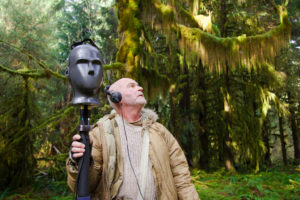New York Film Festival’s Convergence program sees the potential of virtual reality
As executive producer Jonny Ahdout explains, "Sharmeen had a very quick understanding of what it means to formulate creative thinking in virtual reality.
Ahdout acknowledges problems with current VR technology. Both moving the camera and editing are difficult. So is directing the viewer within the VR image. "You want to find the balance between giving people the freedom to look around where they want, but also attracting attention to what is taking place," he says. "With subtitles it's particularly difficult, because you have to piece them into certain parts of the screen. Newer technology will allow subtitles to follow wherever you're looking.00
"We use 3D sound a lot to place a sound in the environment where we want you to look," he goes on. "There's also staging, where if you have an action taking place that's moving from one side to the other, people generally follow that. Something we'll do in cutting is rotate scenes. If you have an action that's ending here in scene one, and the next action in scene two is starting over there, we'll rotate the entire scene so that they overlap on top of each other."
Editing in VR is a major hurdle compared to flat filmmaking. "Brains don't accept quick cuts the way that they do in filmmaking," Ahdout contends. "So we use long takes where you can feel really present in that moment. It's difficult, there's no rulebook. We just know we can't do it the way filmmaking does."
Another problem is the length of time viewers can tolerate VR. Somewhere between five and fifteen minutes seems to work best with documentary pieces and linear stories. Ahdout thinks viewers can stay inside interactive pieces for much longer stretches.
 ...The seams show through in Sanctuaries of Silence, a New York Times Op-Docs production directed by Adam Loften and Emmanuel Vaughan-Lee. A profile of acoustic ecologist Gordon Hempton, the piece follows him as he records sound in the rainforests of Olympic National Park, along the Pacific Coast seashore, and on 46th Street in Manhattan. Like a fancy New York Times Magazine cover story, Sanctuaries of Silence starts with a debatable premise—Hempton's belief that our last refuges of silence are being overtaken—and "proves" it by cherry-picking facts and ignoring whatever doesn't fit his argument.
...The seams show through in Sanctuaries of Silence, a New York Times Op-Docs production directed by Adam Loften and Emmanuel Vaughan-Lee. A profile of acoustic ecologist Gordon Hempton, the piece follows him as he records sound in the rainforests of Olympic National Park, along the Pacific Coast seashore, and on 46th Street in Manhattan. Like a fancy New York Times Magazine cover story, Sanctuaries of Silence starts with a debatable premise—Hempton's belief that our last refuges of silence are being overtaken—and "proves" it by cherry-picking facts and ignoring whatever doesn't fit his argument.
See the full story here: http://www.filmjournal.com/new-york-film-festivals-convergence-program-sees-potential-virtual-reality
Pages
- About Philip Lelyveld
- Mark and Addie Lelyveld Biographies
- Presentations and articles
- Tufts Alumni Bio